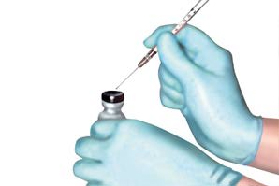Vial Coring Prevention

The medication vial has a small piece called a “stopper” that is used to insert needles. Sometimes a small piece of stopper called “vial coring” gets chopped off and starts to float on the liquid medication. Usually, it is very small and goes unnoticed due to many reasons i.e; the vial is completely labeled or is colored or there is no person available for the lookout. Although vial coring is very small but still this small foreign body is very dangerous as it can be drawn into the syringe and then injected into the patient.
This contamination of vial with foreign body contains a serious threat as it can cause occlusion of arteries which leads to infarction (most commonly pulmonary infarction) and death. Researchers have proven that the contamination of parenteral fluids with particulate matter does not cause any significant damage to previously healthy tissue but it does damages to an already affected tissue such as someone with a pre-existing condition of atherosclerosis or myocardial infarction. The foreign body can also pass into the cerebral blood vessels and can partially or completely occlude them, causing irreversible brain damage, coma, or even death.
Although coring is a rarely occurring event it usually occurs in developing countries as the practice of safe medicine packaging by different pharmaceuticals and fake medicines is a lot higher than in developed counteries. Other risk factors include inexperienced staff, colored or labeled packaging of the vial, or negligence of the healthcare staff.
There is an accurate recommended technique available to reduce the risk of coring to almost zero if it is followed properly. According to this technique “the needle should be inserted at an angle of 45-60 degrees while the needle tip is facing away from the stopper (usually to the upside). The angle is gradually increased with the small amount of pressure while the needle enters the vial. When the needle slope or the bevel is passing through the stopper, it should be exactly at 90 degrees. Smaller needles can significantly reduce the risk of vial coring but they come at a greater risk as it is, even more, harder to visualize the smaller coring.
Disclaimer: The information provided on this website (www.MadeForMedical.com) is only for educational purpose. While we tried hard to write quality articles but still, the articles and the information within them is not guaranteed to be free of factual errors or typos and hence may not be correct. You are advised to independently verify the claims in the articles and make your own conclusion.
